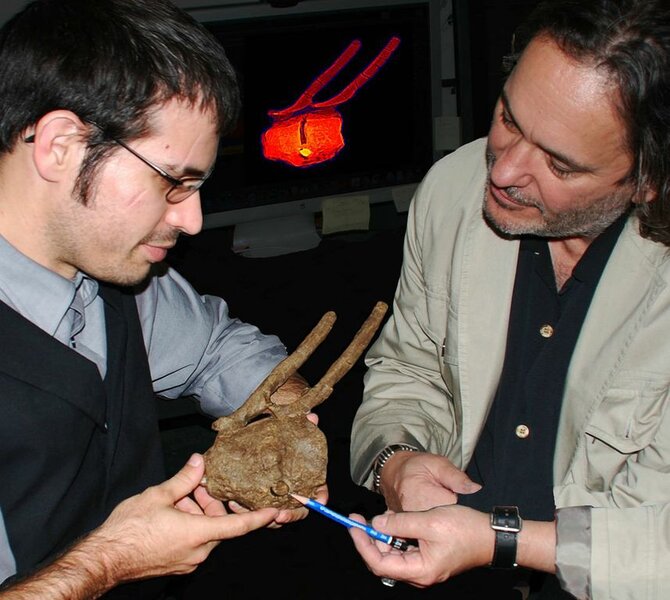T. rex could be the 'tyrant lizard' after all
Loading...
A T. rex tooth discovered in the tail of an herbivore that apparently survived the attack has added new evidence to a century-old debate among paleontologists about whether or not the dinosaur was a scavenger or a predator.
The latest clue in the mystery is a single T. rex tooth, found embedded in the tailbone of a hadrosaur. The duck-billed dinosaur's bone seems to have healed over the bite wound, suggesting that it was alive at the time of the assault, and that it survived.
“The discovery of the tooth surrounded by healed bone is ironclad, direct evidence that this T. rex attacked a living animal, and supports the notion that T. rex engaged in predation,” said Robert DePalma, a paleontologist at the Palm Beach Museum of Natural History in Florida and a co-author on the study, in an email interview.
“All of the evidence thus far proposed has been indirect and circumstantial," he wrote. "There never has been an actual bullet for the smoking gun.”
The dino-drama unfolded about 66 million years ago, in what is now South Dakota, when the American northwest was swathed in green and riddled with streams and rivers. The precise narrative is impossible to reconstruct, but it appears that the T. rex bit into the herbivore’s tailbones and was subsequently fended off. One of the aggressor’s teeth, a 1.5-inch crown, was sacrificed in the effort, wedged in the fortunate dinosaur as a token of survival.
The findings, published in Proceedings of the National Academy of Sciences, does not suggest that the T. rex never scavenged for food, but that it was also capable of hunting its meal, the authors say.
“Any 11-year-old knows that a T. rex ate anything it wanted,” said David Burnham, a University of Kansas paleontologist and a co-author on the study, in a phone interview. Dr. Burnham noted that most predators will scavenge when convenient.
Still, other paleontologists disagree, citing evidence that the dinosaur’s diet was limited to foraged carcasses and ill animals that put up little fight.
“The bulk of data indicates T. rex was an opportunist much like a hyena,” said Jack Horner, a paleontologist at the Museum of the Rockies in Montana, in an email interview. “This new find certainly does not refute that hypothesis.”
In 2011, Dr. Horner and colleagues published in PLOS ONE findings that the fossil record in the American northwest did not evince an ecosystem in which the T. rex could have been a predator.
Generally, an ecosystem has at least 75 percent more non-predators than predators, the study noted. But about the same number of T. rex skeletons and Edmontosaurus fossils, an herbivore and one of the T. rex’s main food sources, were found in Hell Creek. For the ecosystem to be sustainable, T. rex would had to have been an opportunist eater, levying its enormous bite on dead, or already weakened, animals.
"This find, while very novel, does not falsify our work looking at the entire dinosaur fauna of the Hell Creek Formation of eastern Montana where the total number of identified dinosaur skeletons in the field do not support T. rex as an apex predator in this paleocommunity," said Mark Goodwin, an author on that study and a paleontologist at The University of California Museum of Paleontology.
Other research on the topic has also noted that T. rex was too slow and short-armed to be a formidable predator. Based on those findings, another explanation for the rogue tooth is that the hadrosaur was already injured when a hunting-challenged T. rex lunged for it, said Dr. Horner.
“There is no way to determine the fitness of the hadrosaur, nor the way in which the T. rex might have bitten the hadrosaur,” said Horner. “The images leave a lot to the imagination and therefore I'm not even convinced that the T. rex didn't just bite into a dead animal that had a previously healed injury.”
But other evidence suggests that the T. rex was equipped with features that would make it something for other animals to worry about. A 2011 study from The University of Liverpool found that the T. rex had the strongest bite of any known land animal. A separate study from that year, published in PLOS ONE, also found that the dinosaur weighed up to nine tons, revising earlier estimates that had underestimated its terrifying bulk by four or five tons.
The structure of modern ecosystems suggests that T. rex’s enormous size and terrible bite would put it at the top of the food chain, said Burnham.
“There is no modern analog for a large scavenger,” said Burnham, noting that the T. rex has anatomically little in common with modern scavengers, like hyenas and vultures, and much more so with modern predators, like the lion. Small, carnivorous dinosaurs were more likely than the T. rex to have been the scavengers in the Cretaceous-period ecosystem, he said.
“T. rex as a predator is on top of the food chain. T. rex as a scavenger would be at the bottom of the food chain,” he said. “So common sense tells us that it shouldn’t be a scavenger.”
Burnham said that the team is now investigating how the T. rex might have hunted, especially as a small juvenile. One idea is that the juvenile T. rex might have hunted in packs, he said.






